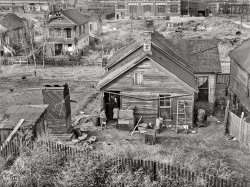
MAY CONTAIN NUTS

Search Shorpy
SHORPY ART

Framed or unframed, desk size to sofa size, printed by us in Arizona and Alabama since 2007. Explore now.
Join and Share
Ad-Free Shorpy
Shorpy is funded by you. Patreon contributors get an ad-free experience.
Learn more.

Recent comments
- Baked goods to go
- Tires
- A Certain Robot
- Still Standing
- All wound up?
- Springy
- This one is inspirational.
- Seasonal Work
- Tomaeto, Tomahto
- Truck ID
- Horton Hears a ...
- From a buggy company came ...
- They call me Mister Horton
- Still Run
- Someone fed Jack some bad info.
- A Beautiful Machine
- It's official.
- Olive Brand Sportswear
- I still have a grudge against Texaco
- No GPS?
- CFG Bank Arena
- Van Lines
- Closed Station?
- John Vachon
- Folding Chairs
- TEXAGO
- Fragi-lay
- Classy
- Passenger seat
- No tipping
Member Photos
The Shorpy
Printporium
Printporium
Search Shorpy
Search results -- 30 results per page
- Tomatotown: 1941
- ... of canners W. Grason and Nannie Winterbottom and a lumber yard owned by architect/builder J. Benjamin Brown. Mr. Brown designed many of ... wonder if the green-on-top signal is a carryover from the railroad signals of the day? "High green" was called out between the engineer ... Posted by Dave - 09/04/2022 - 5:00pm -
![Tomatotown: 1941 August 1941. "Cambridge, Maryland, home of Phillips Packing Co. tomato canning plant." As well as Phillips Hardware at the corner of Muir and Race streets, and a green-on-top stoplight. 4x5 inch acetate negative by John Collier for the Farm Security Administration. View full size.
Only standard lights in sightI'm surprised the Phillips Hardware building still has its cornice - its neighbor doesn't:
Green on Top?How can you tell from a black-and-white photo?
Never MindSaw it when I enlarged the pic.
The Bros.The same pair of brothers - Levi and Col. Albanus Phillips Sr. - owned the hardware company and the packing company. After the obligatory Massive 1910s Fire in Cambridge's main commercial district destroyed the hardware store and others, the brothers purchased the sites across Race Street that had been occupied by the home of canners W. Grason and Nannie Winterbottom and a lumber yard owned by architect/builder J. Benjamin Brown. Mr. Brown designed many of the buildings that rose from the ashes of his business and others in the fire zone.
From 1910 to 1923, before the property at Race and Muir was sold to the hardware company, it was owned by Mr. and Mrs. Winterbottom, Levi Phillips (and his wife Florence), and Albanus Phillips (and his wife Daisy). All four Phillipses died between April 1945 and January 1949.
The building's most recent use is as a venue for special events.
https://mht.maryland.gov/secure/medusa/PDF/Dorchester/D-380.pdf
Nice variety of pumps... but the "depression brick" siding is an odd pattern I haven't seen before. Hereabouts, we had a good sampling of that stuff around town, along with the asphalt shingle version. When applied well they can be pretty convincing from a distance. It has started to get harder to find as the old buildings get torn down for what the current folks mistake for architecture.
[Especially hard to find in this photo! - Dave]
'tis hard to see here- how'n heck can I get it to move? On the othe hand, if I leave it here I can only make a single mistake, try to correct it and the possibility is endless.
Guess it's your move, Dave.
I'll bet a buckthat sign said Shorpy. Best store in town.
The Phillips Hardware Co. building still looks good. Initials PHC are still in each decorative transom window. Fate has not been so kind to the building on the right. In an effort to make it look modern, an owner stripped away or covered up architectural detail and replaced the large upper story windows with much smaller windows that cannot be opened. I guess they don't want natural light or fresh air up there.
High Green?I wonder if the green-on-top signal is a carryover from the railroad signals of the day? "High green" was called out between the engineer and fireman when approaching a clear (or go) signal. This in itself may have carried over from the semaphore type signals when the arm "dropped" down to show a red signal and the arm or blade was horizontal.
[It's green on top only on Muir Street. On Race Street, it's red on top -- the signal has just three bulbs for all 12 lenses. To get red on top for both streets you'd need a more expensive 12-bulb signal. - Dave]
Red=stop, green=go, yellow=confusionFollowing up on Dave's explanation, it's easy enough to see how it worked for red and green, but what about the middle light?? Without some kind of rotating baffle, it would show yellow for both directions: "proceed with caution" in theory, but surely accidents waiting to happen in practice.
[Back in the day, stoplights often showed yellow (simultaneous with red) when changing from red to green. This would be one of them. - Dave]
OK, both yellow and the red/green would be illuminated simultaneously, so you would know- hopefully! - if your yellow meant turning to red or turning from it; still rather confusing ... I think they would have been better off with only the two colors.
Start of the Phillips empireThis is the same Phillips family that went into the seafood business and eventually opened Phillips restaurants and airport locations present today. Also, you may find their products in the frozen foods section of your local supermarket.
(The Gallery, John Collier, Small Towns, Stores & Markets)](https://www.shorpy.com/files/images/SHORPY-8c25766a.thumbnail.jpg)
- Proviso Perspective: 1943
- April 1943. "Tracks at Chicago & North Western railroad's Proviso yard, Chicago." Kodachrome transparency by Jack Delano for the Office of War ... Posted by Dave - 06/28/2022 - 4:50pm -
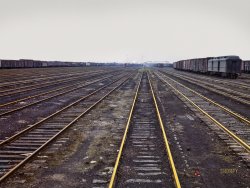
- Star Vehicle: 1920
- ... that in the 70's, we had a 1912 but with a flatbed as a yard hack. It was a bonebreaker, you could only steer when it was moving. Oh ... of August 23, 1919 mentions Wallace Reid's accident in a "railroad wreck scene which was so realistically produced that Reid was injured ... Posted by Dave - 09/13/2011 - 9:54pm -
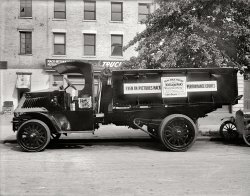
- Chicago & Alton: 1901
- ...
Illinois Coal Handling Mazonia was the name of a railroad junction point. This was not a normal railroad coaling tower designed ... figuring, if there are 50 rails there at 130 pounds a yard that would be approximately 2,860,000 pounds.
But how? A second to ... Posted by Dave - 12/17/2020 - 11:19am -
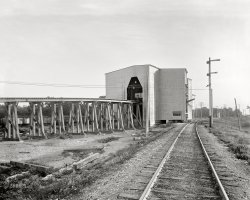
- No Left Turn: 1948
- ... one could still find their way around because Sunnyside Yard had floodlight towers, similar to the Detroit moonlight towers, and that ... Rail Yards, used today extensively by Long Island Railroad, NJ Transit and Amtrak (including a car washing station). A few ... Posted by Dave - 06/30/2013 - 12:18pm -
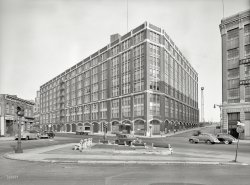
- The Pool Board: 1943
- ... 1943. "Freight operations on the Indiana Harbor Belt railroad between Chicago and Hammond, Indiana. The engine crew, engineer and ... were the different rings, for example "HB Tower:2 short; A Yard:1 long,3 short; HX Tower:1 long, to which a wiseguy added, "...and one ... Posted by Dave - 09/29/2013 - 11:41am -
![The Pool Board: 1943 January 1943. "Freight operations on the Indiana Harbor Belt railroad between Chicago and Hammond, Indiana. The engine crew, engineer and fireman report at the roundhouse office to be assigned their engine and given orders for the day. The cylinder at the left is the pool board; it lists the names of the men and the order and shift in which they will work." Photo by Jack Delano. View full size.
Wooden box with crankAnyone know what the wooden box with a crank handle is on the side of the desk over the trashcan? Being over the trash suggests some sort of shredder, but it's hard to imagine what they would have that needs shredding.
A little cranky?@Carey - that is a telephone ringer. Inside the box is a magneto which generates a voltage so the operator knows there is an outgoing call. I used to have one just like this, which had bells on it like the one on the desk laying horizontally. They put out a good kick if you wanted to play a joke on someone.
One long waitThe crank is almost certainly a ringer for the phone system.The wooden box is in character for the elderly, in-house phone set ups. In the early 70's, B&O trackside phones in places had a crank on a wooden box with a mouthpiece from a Laurel and Hardy flick. Penciled inside the cabinet were the different rings, for example "HB Tower:2 short; A Yard:1 long,3 short; HX Tower:1 long, to which a wiseguy added, "...and one long wait!"
To use the phone, first you'd pick it up and make sure it isn't in use, then ring the call for your party,the other end would answer with a short ring and then you talk by pressing a button. [this was to prevent background chatter; it was one big party line...] All of this was made antique collectibles by the radio, even to the removal of the phone lines themselves.
With the callboard nearby, someone in this office is a crewcaller, so the in-house phone line is for talking to the dispatcher, the trainmaster, the engine facility, etc. There also is a phone line to the outside, and if a crewman was within a certain distance from this office, callboys would go out and call at their doors. My name was on a similar board back in the "analog era". I wish I'd saved my peg.
State-of-the-Art CommunicationsThat box with the crank is a magneto generator that produces ringing current of about 108 v.a.c.
It's matched up with the three oak ringers (one on the desk, two on the wall above the window), and the oak 3-hole jack box behind the archboard on the desk. These also work with the three selector boxes between the ringers on the wall.
Apparently he has 3 phone circuits. He chooses the one he wants to use with the jack box. To make an outgoing call, he cranks the magneto. Incoming calls are announced by the ringers, and the selectors control when the ringers announce an incoming call for this office.
Information about railroad telephone equipment of this era, including links to archived user's manuals, can be found here.
If you see oneyou’ve seen 'em all. There must have been a written code somewhere that all railroads subscribed to regarding yard office ambience. They were all the same until recently. Wires and bells and speakers everywhere. Wooden floors, bare bulbs, block phones, doors that closed somewhat tightly, and restroom facilities that challenged the dignity of anyone other than a rail. (The old Humboldt Yard Office of the Milwaukee Road had a urinal that consisted of a large sheet of tin fixed to the wall that one [there were no women in those days] would pee against, and the urine would run down the tin into a horizontal length of rain gutter.) Although I can’t be certain, I’m going to guess the featured picture was taken at the IHB Blue Island yard. The two guys in the window are in their locker room, apparently waiting for a clearance and orders, or getting ready to tie up.
Carbide lampThe bright image in the lower window appears to be a carbide lamp probably an oxweld they were extremely common for that time.
Pool boardHow does the pool board work? Is it meant to be rotated when there's a shift change, so that the current shift is visible and the off-duty shift is on the "dark side"?
What information is being represented? Why are the tags in pairs - is it driver/conductor teams? Does the column of tags with labels represent assignments to trains? Is the Pool In/Pool Out like the bench?
Merch, baby!The Shorpy Store (TM) doesn't seem to stock that attractive Shorpy(R) brand wastebasket... that's a missed revenue opportunity!
The tags.As this photo was taken in a roundhouse/engine terminal office, they'd be paired for an locomotive engineer and fireman. IHB in those days was a terminal/switching road, so the assignments would most likely be for switching jobs or transfer runs.
Pool Board quick [?]On B&O at least, the engineers' pool and conductors' pools were separate. Since one pool had a few more crews than the other, this was necessary.
Engineers pools included a fireman, and later, a trainee, while the conductors turns showed the head brakeman,flagman, and in 1943, maybe a swingman. If a position was vacant, no peg was there. Bulletins were issued weekly advertising vacancies on regular jobs/pool crew and new jobs.
If you look to the right side of that board, those tags seem to show regular train or probably yard assignments; these would show the engineer, fireman, conductor [yard foreman on B&O] and the switchmen.
In practice, if a man was off, i.e. sick or vacation, etc., his tag was removed from his regular assignment and shown in what ever status. Somewhere on that board are extra boards for engineers, road conductors, brakemen, etc. As these extra men are called, their pegs are placed on the appropriate job with its regular men; when their trip is over, they are marked back up on the extra list at the bottom.
Note there is a window behind the board; this way a man can look at the board to see where he "stands" as he marks up, and see where everyone else is too. (The crews were kept on the other side of the window. Time slips, orders, etc. were handed through the "dutch window" above the caller's head.An experienced man could look this board over and tell you what job he's working tomorrow, and what job you're working too.[Sorry, Dave. This is about as quick as I could make this...]
(Technology, The Gallery, Jack Delano, Railroads)](https://www.shorpy.com/files/images/SHORPY_8d24378a.thumbnail.jpg)
- Mike Evans: 1943
- ... "Mike Evans, a welder, at the rip tracks of the Proviso Yard, Chicago & North Western R.R." 4x5 Kodachrome transparency by Jack ... what make me almost enjoy waking up and heading out to my railroad job each day!
RIP Rip = Repair In Place -- A yard track where ... Posted by Dave - 08/30/2012 - 4:44pm -
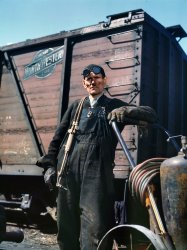
- Ashcans on Van Horn: 1935
- ... previous poster - this area is quite near the large train yard - on the edge of Price Hill, and was probably swallowed up sometime in the ... still exist...but haven't seen those others (except the railroad).
666 For Colds & Fevers I collect antique bottles, tins ... Posted by Dave - 08/12/2012 - 3:31pm -
![Ashcans on Van Horn: 1935 December 1935. Hamilton County, Ohio. Vicinity of Cincinnati. Dwellings on Van Horn Street. View full size. 35mm nitrate negative by Carl Mydans.
Judging by the graffitiAt least the gangs seem friendly...
666"666" is a medicine for colds and fever? Or a curse?
That's a very vivid picture, though. You can just imagine walking straight ahead, on down the hill.
[Cold medicine. - Dave]
Van Horn StreetYes, sadly, I think so, Dave. This 1838 Bird's Eye Map of Cincinnati shows a Horne Street...but it likely predates Van Horn St, although it's in the general vicinity of Ward 20 (the 1900 census shows Van Horn in Precinct C and D of Ward 20). [Unfortunately, while nicely drawn, the 1900 Bird's Eye Map doesn't seem to include any names for streets, businesses, or points of interest.] The current Google satellite map indicates that there's an expressway about there...and major train tracks.
It also seems that it was possibly in the amazing-looking Price Hill area. Can some locals share insights into Price Hill?
Price HillI can share a bit of insight on Price Hill. Once upon a time was a nicer area, but now it's very rough - poor, violent and rundown. It's on the lower west side of the city, close to the river - a lot of cheap historic housing to be had, if you can stomach the crime and the overall depressed feel to the town.
One of the famed "Seven Hills" in Cincinnati. Inclines were a big thing back in the day.
Price HillAT was a bit harsh on Price Hill. It's really not a poor gang infested slum that AT described. For some reason that's how too many people think of Price Hill. I'm not sure if it's learned from the media or something someone puts together in their own mind.
I'm not aware of a Van Horn St, but from the looks of the photo it could be taken from somewhere in East Price Hill. That's the part of Price Hill closest to downtown Cincinnati. If I had to guess, I would place it around Maryland Ave or near the bottom of Glenway Ave. Considering the street is so narrow and it looks like the the houses are not at street level on the left side, there are only a few places this could be. Maybe I'm not looking at the picture right?
There was a time in Cincinnati when a lot of street names were changed from their German names to more Anglo-Saxon sounding names. Not that Van Horn sounds German, but it's possible the street name no longer exists.
http://pricehillblog.com
Here's a good page of pictures of the historic Price Hill Incline.
And here are some photos I took recently from the other direction (looking down from the top of the hill, where the incline once stood).
Van Horn?I live in Cincinnati and know the town well - however, I've never heard of Van Horn, nor can I find it online. It looks similar to some alleys I've been in, but I can't seem to place any landmarks. Any idea on how I could find it?
[It's probably long gone. A lot of these old neighborhoods and streets disappeared in the slum clearance projects of the 1950s and 60s. You look where they used to be and find expressways and overpasses. - Dave]
Price HillI made the comment on Price Hill. Sure, parts of Price Hill are fine, just like any town. But having worked there (near Considine, across from the police station), I can say with assurance that my viewpoint does not come from the media.
I have to concur with previous poster - this area is quite near the large train yard - on the edge of Price Hill, and was probably swallowed up sometime in the midcentury.
Van HornIf you draw an line from Carr at Dalton Street to Baymiller at Poplar, you might have an idea of the eastern boundary of the Ward/Precinct. Ninth Street was broken up to make room for the highway long ago - you can see a remnant of it if you search for Ninth Street West (9th St W) in 45203 on the map. That would be the southern boundary of the area. I assume Van Horn made up the northern part and the RR tracks the western. What we're looking at here is an area that time forgot - west of downtown/Over the Rhine and east of Price Hill. I don't know what they call that neighborhood now but I think the freeway killed it - not much there right now but a few factories/industries.
Van Horn StreetThanks for the insights, links and pix.
Van Horn is Dutch, and there are some other Dutch named streets/alleys in that vicinity (east of Mill Creek).
The 1900 census shows Van Horn being part of the Ward 20, Precinct C boundary with Ninth, Baymiller and Carr...and part of the Ward 20, Precinct D boundary with Baymiller, Barr, RR, and Carr.
I know Ninth and Baymiller still exist...but haven't seen those others (except the railroad).
666 For Colds & FeversI collect antique bottles, tins and other items and I just so happen to have an actual labeled, corked and sealed bottle of this medicine with the original contents. Yes, it is a strange name for a medicine, but many patent medicines back then had even stranger names as well as ingredients. 666 was made in Minneapolis, MN according to the (bright red and black, no less) label on my bottle. It supposedly cured colds, fevers, ague, catarrh, rheumatism and almost any other malady one could think of. Man, I would absolutely love to have one of those advertising signs for my collection! Another excellent photograph.
~ Boone H
Van Horne AlleyVan Horne Street was in what is now Queensgate. It ran east to west between Seventh and Eighth streets and between Carr and Mound. That area is now completely industrial and there seems to be no trace left of Van Horne Street's existence. I think it was right behind the buildings put up in the 1960's on the south side of what is now West Eighth. In the Hamilton County Auditor's website, a lot of these properties make reference "Vanhorne Alley."
Map here.
Price HillCan you tell me anything about who the Considine was whose name is found in Price Hill streets, Considine Ave, Considine Lane etc? Can you say whether the lower part down by the river and east toward the railroad slot was Irish in the 1870s-1880s? email: ryan90274@yahoo.com (that stomach is scary)
(The Gallery, Carl Mydans, Cincinnati Photos)](https://www.shorpy.com/files/images/8a00715u.thumbnail.jpg)
- Bonus Tracks: 1906
- ... to mention the noise and smoke of the adjacent rail yard. Rent in 1906 was $20 for a four room apartment.
Today's picture ... the "points" -- a favored method used by the Pennsylvania Railroad in its larger terminals. Ammonia was also injected into the compressed ... Posted by Dave - 08/14/2012 - 11:14am -
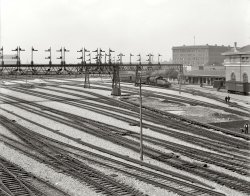
- Amarillo Yardmaster: 1943
- ... back memories. My father was a yardmaster for the Erie Railroad in Meadville, Pa. in the 1950's and 60's. As a child I would go with my mother to pick him up after work and would go into the yard office. He was the westbound yardmaster and his clerk sat directly across ... Posted by Dave - 08/10/2012 - 4:15pm -
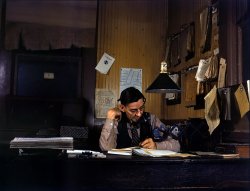
- Going Nowhere: 1930
- ...
Next stop, Willoughby! It looks like the old railroad car in that "Twilight Zone" episode.
Is Comfy It IS more comfy ... in daily use: the stub that goes from the former Potomac Yard (and Conrail/Amtrak mainline) east into Old Town Alexandria, dead-ending ... Posted by Dave - 07/22/2012 - 6:43pm -
![Going Nowhere: 1930 "Car interior. Washington & Old Dominion R.R." Our third and final look at Pennsy car 4928 on the tracks of the W. & O.D., whose right-of-way is now plied by commuters taking I-66 into Washington. 8x10 glass negative. View full size.
Next stop, Willoughby!It looks like the old railroad car in that "Twilight Zone" episode.
Is ComfyIt IS more comfy than a modern jetliner. I volunteer at a railroad museum where we refurbish and display old RR cars and have sat in many of these. The seats are like your couch at home; there is more than ample room to cross your legs and the passenger next to you can still get up and leave his seat without tripping over your legs. Some of the newer (1920s-30s) ones have pivoting seats that let the whole bench swivel toward the aisle.
Like so many modern things, the "good" has been engineered out of it. We used to get things such as durability and ruggedness for free, but now it's all designed out as unnecessary, as exemplified by the sardine-can seating of modern airliners.
[I'll bet airplane seats are pretty durable. And of course there's a reason airline seats are closer together. The per-mile cost of moving a pound of passenger through the air is much higher than it is on the ground. - Dave]
ContrastWhile a bit seedy and mussed up, the interior of Old 4928 looks fairly decent. Like an old dowager queen waiting for a rescuer, hoping for salvation. But, alas, it probably never came and we are the worse off for that.
The W&OD lives, sortaThe Washington & Old Dominion ran from Alexandria out to Purcellville in the Blue Ridge Mountains. Today, its right-of-way is a much-used bike path that stretches from the west end of Alexandria west, passing through wooded areas, suburban sprawl, and eventually rural stretches as it gets outside the Washington Beltway. It's a wonderful trail to ride.
Most folks don't realize that one small (maybe a mile or two) of the RR still is in daily use: the stub that goes from the former Potomac Yard (and Conrail/Amtrak mainline) east into Old Town Alexandria, dead-ending as siding at the warehouses on the banks of the river. On a daily basis, two- and even three-engine trains of boxcars and coal hoppers pass by my office window, servicing the coal-fired Mirant power plant and the riverfront warehouses. With Old Town becoming increasingly an upscale tourist destination, it's nice to have reminders that it's still a working port!
W&ODI-66 does not follow the W&OD Railroad. The W&OD's right of way is instead now a trail, from Shirlington to Purcellville. The right-of-way west of Purcellville was sold before the rest of it, so it will likely never extend further west than that.
[I-66 uses two stretches of W&OD right-of-way through Arlington. - Dave]
Looks ComfyThis car looks about 1000 times more comfortable than the coach seats in a modern jetliner (and the TGV trains in Europe for that matter).
Doesn't look comfortableHard wooden armrests, scratchy fabric, no headrests, and no lumbar support all add up to uncomfortable in my book.
All Aboard...When I was a child, and the Pennsylvania Railroad had not yet become Penn Central, there were still 1910-1938 era cars in use similar to this one.
Far from being uncomfortable, they had soft mohair seats with very plush and pliable springs, and those seatbacks could be shifted to the front or back of each bench, allowing one to ride facing forward, back, or to create two adjacent seats that faced each other for a cozy group alcove. None I ever rode on had carpet runners like this one. They had linoleum or tile.
The thing you cannot see in the picture is how noisy those very oldest cars were to ride in. The windows, when they were wood, banged, and the tracks were not yet welded into a seamless beam (done for the Metroliner in the 1970's), so at every segment of rail the windows rattled and the train went clack-clack-clack.
The silversides of today are quiet and smooth riding, but they have none of the art deco and pre-WWI charm of these cars. Each train ride was an excursion into art history. You never knew in advance what art era you would be studying.
W&OD TrailHere's a map showing the trail.
(The Gallery, D.C., Harris + Ewing, Railroads)](https://www.shorpy.com/files/images/20625a0.thumbnail.jpg)
- California Here I Come: 1943
- ... freight about to leave for the West Coast from the Corwith Yard at Chicago. View full size. 4x5 Kodachrome transparency by Jack ... at War" which chronicled this trip and also contained many railroad photos from other parts of the country. The book is out of print but ... Posted by Dave - 07/17/2012 - 10:04pm -
![California Here I Come: 1943 Santa Fe freight about to leave for the West Coast from the Corwith Yard at Chicago. View full size. 4x5 Kodachrome transparency by Jack Delano. This is the freight Jack accompanied from Chicago to California in March 1943, taking many pictures along the way for the Office of War Information.
CaliforniaIs this Delano still alive?
Laurent Wiame from Switzerland...
[Jack Delano died 10 years ago at the age of 83 - Dave]
Thank youThank you for all the amazing color pictures by Jack Delano...
California or BustI hope you have all of the pictures from Frank's trip from Chicago to LA, I certainly would love to see them. So Frank worked for the war dept? He sure was lucky to be able to travel across the country for his job and getting paid for it.
Iron Horse at WarHe wrote a book entitled the "Iron Horse at War" which chronicled this trip and also contained many railroad photos from other parts of the country. The book is out of print but might be found on E Bay. Unfortunately, the book is in Black & White.
That train isn't moving anytime soon!The train still has a blue flag hanging on it. That means that there is still someone working on it. Each worker puts a blue flag on the front end of the train (or on the track ahead of the train) and ONLY that man can remove it. Once all blue flags are removed, the train can then proceed.
Jack DelanoMany thanks for these fabulous photographs. Just stumbled across them ... Delano was an artist of the finest caliber, and you honor him by posting these for future generations to enjoy. Excellent work.
Jack from Chicago
(The Gallery, Kodachromes, Chicago, Jack Delano, Railroads)](https://www.shorpy.com/files/images/1a34699uuu.thumbnail.jpg)
- Factory Town: 1910
- ... me and you who built the Promised Land".
We made their railroad bridges. We ran their driving wheels
And the towers of the Empire ... It used to be an industrial area with a large train yard. Now it's filled with Ikea and other large stores and huge apartments. I ... Posted by Dave - 07/29/2012 - 1:32pm -
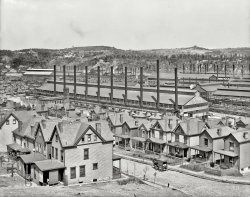
- Standard Service: 1939
- ... consisting of a few houses, general store , and railroad station ." Medium format acetate negative by Arthur Rothstein for the ... street) and it went past a grain elevator and a lumber yard. In the late 60s, my family moved to a house across the street from the ... Posted by Dave - 01/14/2018 - 11:54am -
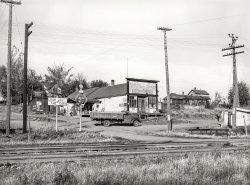
- I Think I Can: 1906
- ...
[I did notice that Dave. However, coal has been the railroad's solid fuel choice for a number of decades. - Mal]
The weather on ... it's still sitting in storage in the shops at the rail yard at the foot of the mountain.
Kilroy That's probably his first ... Posted by Dave - 08/08/2012 - 3:11pm -
![I Think I Can: 1906 Circa 1906. "Engine, Mount Washington Railway, White Mountains, New Hampshire." The little engine that could also serve as a portable pizza oven. 8x10 inch dry plate glass negative, Detroit Publishing Company. View full size.
New Hampshire's Cog Railway"The Cog" as it's known has been (during the summer) delivering passengers (mostly tourists) to the summit of Mount Washington since July 3rd 1869. Soot spewing coal fired boilers have been largely replaced with cleaner diesel units, although coal is still used on some early morning ascents. The boilers are canted as in this photo so that they'll be level during the steep ascent and descent.
[You'll note that this engine is not coal-fired. - Dave]
[I did notice that Dave. However, coal has been the railroad's solid fuel choice for a number of decades. - Mal]
The weather on top of the summit can be among the most severe in the country and is where the world's record wind speed of 231 MPH was recorded. Hence the mountain's timberline is at only 4,000 feet.
Train quesitonProving I know very little about trains. Is it supposed to be stuck up in the air that way?
Railway to the MoonThis engine served on the cog railway that still ascends to the 6,288 ft summit of Mt. Washington. It is the oldest rack-and-pinion rail system in the world (1869). Before construction, the project was derided as a pie-in-the-sky "Railway to the Moon." So it truly was the little engine that could!
The numeral 1 on the engine identifies it as the rebuilt "Mt. Washington," originally named "Falcon." Incredibly, it's still sitting in storage in the shops at the rail yard at the foot of the mountain.
KilroyThat's probably his first appearance, behind the tender.
That bend?T'was like that when we took it out dis mornin'. Honest.
Not On the Level!The reason the locomotive boiler is on a 'slant' in regards to the frame and cylinders is that when the locomotive is working and climbing on the way to the summit, the water and firebox within will be more or less horizontal on the grade.
The large dome accumulated steam well above the level of the water.
As wood was the fuel, a long smokestack with a large opening at the top which is covered with a screen was applied to catch sparks and help prevent fires along the right of way.
The screen has a latch so it could be opened.
Wood is easy to fire, burns clean, and leaves little ash.
Coal has more heat value by weight, and was used in later years.
Unlike most of the other locomotives featured on Shorpy, this one does not need sand for traction nor has piping or a sand dome for sand application.
The spoked locomotive wheels riding on the rails are not powered, the movement supplied by large pinion gears driven by the four external steam engines, the gears' teeth mesh with the teeth on the horizontal rack between the running rails.
The teeth of one of the 'cogs' or pinion gears can be seen above the front spoked wheel and frame.
There appears to be a band-type friction brake below the front coupler operated from the cab by the long reach rod and lever.
The operating handle for an injector to put water into the boiler can be seen inside the cab side window.
Thank You.
Leaning Into the WindThese cog railway locos have slanted boilers because when they are climbing the hill, they want to boiler level to prevent "priming", that is, water getting into the steam pipes (very bad). The Pikes Peak locomotives were similarly slanted.
[In other words, the boiler is level when the engine is ascending or descending the grade. Note that the passenger car stays on the uphill side and that the loco always faces "up," with descents made in reverse. - Dave]
Kilroy was here?I wanted to see Kilroy so bad that I ran my computer up to 400+ on the zoom and still couldn't find him. Oh well, I love this cog railroad and it is definitely bucket list worthy.
Dave, thanks for the location pic and I don't know how I missed this guy.
One of the neatest trips in North AmericaI am lucky to have been able to take this trip three times. All with steam power. One one trip; we hiked to the Lake of the Clouds Hut, and back. Awesome views. My last trip, we saw snow at the summit in late July. The TV station was still broadcasting when I was there. The weather guys up there were fascinating. Everybody should do this once if you can.
ThanksThanks to everyone for your input. This is why I consider Shorpy such an education in so many areas.
Fond memories of a trip up Mt. WashingtonThe summer I was 13 I rode the cog railway up Mt. Washington with my parents and brother. On the way up my brother & I stood in the aisle of the car and found ourselves leaning forward at such a steep angle I thought I'd pitch forward on my face. We also visited the famous flume. What great fun! I loved New Hampshire.
Thanks for the memories, Dave.
(The Gallery, DPC, Railroads)](https://www.shorpy.com/files/images/4a13651a.thumbnail.jpg)
- Yardman: 1942
- December 1942. "Chicago, Illinois. In the Proviso Yard roundhouse, Chicago & North Western Railroad." Nitrate negative by Jack Delano for the Office of War Information. ... Posted by Dave - 08/11/2022 - 5:33pm -
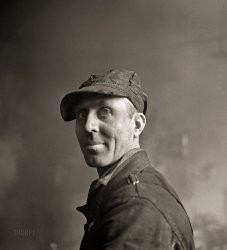
- Needles: 1943
- ... A general view of the Atchison, Topeka & Santa Fe rail yard." Photo by Jack Delano, Office of War Information. View full size.
... wonders about vertical clearances on the Santa Fe Railroad. Especially on the main lines, they were so generous that some tall ... Posted by Dave - 01/23/2013 - 5:33pm -
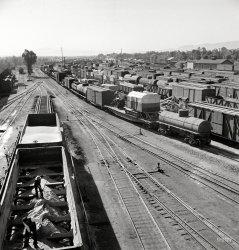
- Bridges of Pittsburgh: 1905
- ... to be numbered 301, but can't quite make out the number, railroad initials or wheel arrangement. If this is the Monongahela Railroad ... Of interesting note is the combination and coach in the yard near the Atlantic (4-4-2) locomotive. Though more than likely they are ... Posted by Dave - 07/28/2012 - 4:55pm -
![Bridges of Pittsburgh: 1905 Circa 1905. "Pittsburgh from Mount Washington -- Monongahela River with Smithfield Street Bridge and Pan Handle Bridge." Panorama made from two 8x10 inch dry plate glass negatives. Detroit Publishing Company. View full size.
Little engine that couldThe steam locomotive bottom left has me wondering. Upon magnification it appears to be numbered 301, but can't quite make out the number, railroad initials or wheel arrangement. If this is the Monongahela Railroad the initials could be PRR or P&LE. They did acquire two class D-3 locos in 1904 and 1905 with a 4-4-0 wheel arrangement AND they were numbered 301 and 302. Then there was a 2-8-0 arrangement purchased in 1903 if the number is 201. Oh well, regardless of identity it certainly looks like an "engine that could" do its duty.
Topography underneath the cityWhat I love about this shot is you can see the topography that lies beneath all the buildings of Pittsburgh today.
The HillGreat shot of the East side of the city. Long before Boulevard Of The Allies and the Parkway took over the landscape. Those barren hills to the North are now home of Pittsburgh University. And there's a great bike trail where those rail cars and the mill once sat. This is all less than a mile from my place. I never get tired of looking at the old shots of this city and seeing how it has evolved into what it is today.
LOTS to LQQK at!!!That is just a totally awesome photo right there with lots and lots of stuff to look at. Just the railroad stuff (my favorite subject) can amuse one for hours. All those passenger and freight cars and rail served industries and in 1905 they probably kept track of where everything was and where it was going than they do now with computers, GPS tracking and less rolling stock and rail served industry!
In looking at the sky, though, one should be glad we DO have an EPA now. Of course, I suspect there may be just as many pollutants in the air now, it's just that we have cleaned them up so that you can't see them or smell them as well.
[Your suspicion is incorrect. The air here was much dirtier a century ago. - Dave]
I suspect you're right. --RJ--
Air QualityMeasured not in picograms per cubic liter, but in lbs. of cinder per cubic foot. Holy moley - that is dirty-ass air!
The little engineis a 4-4-2, presumably a P&LE class E-1 engine.
Jim CrowOf interesting note is the combination and coach in the yard near the Atlantic (4-4-2) locomotive. Though more than likely they are currently in storage, it's probable that the cars came off a train oriented like that. You saw that type of orientation quite often in the time of segregation, with black riders being placed in the section forward of the baggage compartment, and whites riding in the rest of the train. This gave rise to calling the orientation "Jim Crow." It would later be applied to special "Jim Crow" cars which had the baggage compartment in the middle of the car and passengers on either end.
(Panoramas, Boats & Bridges, DPC, Pittsburgh, Railroads)](https://www.shorpy.com/files/images/SHORPY_Pittsburgh_Panorama.thumbnail.jpg)
- Fossil Fuel: 1920
- ... (except Metro underground). Does anyone know where the railroad tracks in Rosslyn used to be?
[Parts of I-66 were built on the ... electrified for part of its history. The W&OD had a yard along Lee Highway adjacent to today's Key Bridge Marriott.
(The ... Posted by Dave - 09/11/2011 - 4:28pm -
![Fossil Fuel: 1920 Washington, D.C. "Penn Oil and truck." A relic of the Carboniferous Age circa 1920. National Photo Company Collection glass negative. View full size.
DriveshaftI wonder where the driveshaft is. Perhaps this is a portal-type axle where the driveshaft is high into the frame and the the power is converted to the axle via some kind of drop gear mechanism. Otherwise we'd see it angled down from the engine to the differential near the center of the rear axle.
Power AlcoholSounds a lot like ethanol, and yes, you're right. It's not working out. Lower mileage, maintenance worries for the engines, and higher food prices.
Steve Miller
Someplace in a cornfield near the crossroads of America
Rosslyn?If this is the main storage depot for Penn Oil, it would be located in Rosslyn, Va. This was the site of two spectacular fires: one in 1925 and another in 1927. Papers refer to the location as on the old Alexandria road. Not sure what that would be today. There were apparently other tank farms in the area too, so it must have had some rail connection. I don't think there are any tracks in the area now (except Metro underground). Does anyone know where the railroad tracks in Rosslyn used to be?
[Parts of I-66 were built on the Washington & Old Dominion R.R. right-of-way. - Dave]
Alternative fuel 1920s-styleThis photo and this one reminded me of a passage from the 1925 book The Romance of the Fungus World in which the authors, R.T. and F.W. Rolfe, predicted that alcohol would soon replace petroleum for use in combustion engines: "The advantage of alcohol over petrol for this purpose lies principally in the fact that whereas the world's supplies of petroleum, and therefore of petrol, are being gradually exhausted, the supply of Power Alcohol is practically inexhaustible. It is only limited by the earth's capacity of producing plant growths whose products are amenable to the fermentative processes which yield alcohol."
I assume that didn't pan out ....
DriveshaftThis truck most likely had a worm gear rear axle. This places the driveshaft high on the axle housing. And yes, ethanol doesn't work any better today then it did back then. Looks like it took a real man to power that steering wheel.
Tracks in RosslynRosslyn was also served about this time by the Pennsylvania RR, on a branch that roughly parallels today's Metro Blue Line from Rosslyn to the Potomac Railroad bridge. There were also three electric lines running through Rosslyn, in addition to the W&OD, which was electrified for part of its history. The W&OD had a yard along Lee Highway adjacent to today's Key Bridge Marriott.
(The Gallery, Cars, Trucks, Buses, D.C., Gas Stations, Natl Photo)](https://www.shorpy.com/files/images/29356u.thumbnail.jpg)
- Plymouth Breaker: 1901
- ... accommodate the officials who were doing the inspecting of railroad facilities. The inspection engine could run alone while on business, ... to buy it that way as it could be picked up at any coal yard or even a hardware store.
(The Gallery, DPC, Mining, Railroads) ... Posted by Dave - 08/08/2012 - 2:30pm -
![Plymouth Breaker: 1901 Plymouth, Pennsylvania, circa 1901: "Plymouth coal breaker." 8x10 inch dry plate glass negative, Detroit Publishing Company. View full size.
Mechanical DevicesThey may be taking over in the operation of the breaker, but somebody is going to have to do some serious shoveling to unload those boxcars! And it looks as if this is an accepted method as there are several flat cars full of ready cut boards waiting at close hand. I can't imagine what the purpose of the gondola/flat car combo can be for. There seems to be another set in the loading shed and one farther down the other side. Very perplexing!
Perhaps they are processing so fast that they need to use every available car until they can acquire or manufacture new gondolas?
The Parrish BreakerThis photo appears on Wikipedia under "Plymouth, Pennsylvania" and is identified as the second Parrish Breaker.
Here, as everywhere else
Popular Mechanics, 1908
Largest Coal Breaker in the World
The huge coal breaker at Plymouth, Pa., known as "Nottingham No. 15," is the largest in the world. Its capacity is 1,000 cars of a size large enough to carry an equivalent of 7 tons of finished coal each. Not more than 200 ft. from the breaker is a shaft 350 ft. deep from which one of these cars arrives with coal from the mines every 20 seconds.
Here, as everywhere else, mechanical devices are superseding manual labor. In the old-style breaker at least 150 men and boy pickers were employed, but in this breaker a spiral coal-picking machine has made it possible to dispense with at least half of that number. The breaker cost $200,000.
[Note: the breaker pictured above may not be the one described in the Popular Mechanics article. Nor does it appear to match any of the other PA anthracite breakers cataloged at this site.]
Plymouth commentsThe boxcars are likely outbound. Some anthracite customers ordered coal in boxcars, as there was less pilferage. (Note there is another boxcar under the breaker).
Looking at the hi-def image, a locomotive is seen in the distance that appears to be an inspection engine. It has a high cab with the bell mounted on the front end sill. There probably are several business cars behind it; difficult to see at this distance.
An inspection engine indicates a visit from the "brass." The grounds were spruced up ahead of time for sure.
Camelback LocomotiveThe type of locomotive in the back isn't an "inspection" locomotive as another poster called it, but is instead a camelback. This type of locomotive was somewhat common in the early 20th century, but fell out of favor due to people fearing they weren't safe. They still hung around in places like yards and industrial applications; but generally speaking they died out. Only one has been preserved in working condition.
Inspection LocomotiveThe high cab roof, along with the bell mounted on the front deck, says inspection locomotive, an entirely different animal compared to a camelback.
The oversize cab was necessary to accommodate the officials who were doing the inspecting of railroad facilities. The inspection engine could run alone while on business, but often hauled private or business cars, as appears the case here.
BTW, at least two camelbacks have been preserved: DL&W No. 952 4-4-0W at St. Louis Museum of Transport, and CRRNJ 4-4-2W at B&O Railroad Museum in Baltimore.
"American" camelbackShilo would seem to be correct. The construction of the engine more resembles an early "American" type camelback. Not American 4-4-0, but instead this type of locomotive.
The PRR owned six of this class of locomotive, with the B&O having 50. Only one has been preserved of this class, though it is not in running condition. Due to its construction, it is not unexpected for them to be mistaken for inspection trains, which were a very different beast entirely.
This type of locomotive was rendered obsolete by 1910, due to improvements in boiler design. By then, most had been withdrawn from service or rebuilt into "conventional" cabbed locomotives.
Also, only one "modern" Camelback, Reading Company 0-4-0 No. 1187, survives in operable condition. The remaining preserved locomotives are lacking in nature, with Baltimore & Ohio Railroad 4-6-0 No. 173 suffering from a cracked boiler crown sheet and failed boiler certificate, and Central Railroad of New Jersey 4-4-2 No. 592, having been severely damaged when the roof of the museum gave way under heavy load in 2001-2002. Lastly, Delaware, Lackawanna & Western 4-4-0 No. 952, is in no condition to operate, missing may integral parts, and B&O Camelback 2-8-0 #173 (Of this class in the photo) Being too old to consider repair and operation.
BoxcarsCoal shipped in boxcars, rather than hopper cars, was shipped in fifty pound burlap bags. Usually sold in the larger cities to customers who preferred to buy it that way as it could be picked up at any coal yard or even a hardware store.
(The Gallery, DPC, Mining, Railroads)](https://www.shorpy.com/files/images/4a07311a.thumbnail.jpg)
- Lackawanna: 1900
- ... and Western example that operates on the Strasburg tourist railroad in Pennsylvania. The "Camelback" design, which straddled the cab over ... cab and if on the engineer's side, the engineer also. In yard service they were much safer because of the lower speed which was not so ... Posted by Dave - 08/05/2012 - 6:30pm -
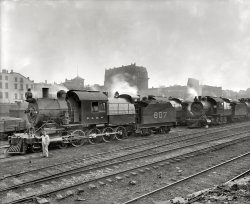
- The Carbon Kid: 1938
- ... three brothers were often told to take burlap bags to the railroad tracks and pick up as much coal as possible that had fallen off the ... Grandfather is arrested for picking up coal in the rail yard after he pushed it off of a rail car. The following month, Grandfather's ... Posted by Dave - 10/14/2015 - 1:34pm -
![The Carbon Kid: 1938 September 1938. "Coal miner's child breaking up large pieces of coal to take home. Pursglove, Scott's Run, West Virginia." Photo by Marion Post Wolcott for the Resettlement Administration. View full size.
Coal miners' kidsThis was apparently very common in coal country in the early 20th century and before. My mom was a coal miner's daughter born in 1910 in Bradenville, Pa. where her father worked the mines and she and her three brothers were often told to take burlap bags to the railroad tracks and pick up as much coal as possible that had fallen off the train cars as they rattled along. They used it to heat their homes in the frigid Pa. winters and her mom would cook with it. When I was very young and went there to my grandma's funeral, I well remember the miles and miles of the most train tracks I've ever seen and coal scattered everywhere. We who are living today have no real idea of how very hard life was in earlier times.
He's going to look sharp in dress bluesWe grew up hearing the family was so poor that Grandfather would pick up coal off of the train tracks. Fast-forward 85 years, through the wonders of newspaper archives digitization: a 15-year-old Grandfather is arrested for picking up coal in the rail yard after he pushed it off of a rail car. The following month, Grandfather's name appears on a U.S.Marine Corps muster sheet at Marine Barracks Port Royal, South Carolina (now Parris Island). The beginning of the Sergeant Major's 40-year adventure.
Fred FlintstoneThe early years.
They almost arrested himthen they found out he had squatter's rights.
ShortsI had an outfit like that as a child. Get up, get in and that's it!
Coal cars rumblin past my door...Both of my parents grew up poor in western PA "coal patch" towns.
Every time I hear the song "The L&N don't stop here any more" I think of the wonderful stories of the hard luck years they endured. How I would give anything to be standing along the "sulfur crick" with rusty old Pennsy H21 and GLa hopper cars of coal (like those in the W Va picture) rumbling by.
"I was born and raised in the mouth of the hazard holler...
Coal cars rumblin past my door..
Now they're standin in an empty row all rusty
And the L&N dont stop here anymore"
Not Only CoalIn the post-war 40's my brand new parents lived in a little rental house on a 15 MPH curve of the local highway. Hundreds of produce trucks would make that turn every day - most at speeds exceeding the recommended 15 MPH limit. This usually caused anything loaded above the top of the truck bed to roll off and into our yard. Late afternoon would my folks and most others from the neighborhood gleaning the assorted veggies FOB.
Thrown in jailMy father got thrown in jail for picking coal off the tracks, Easter Sunday 1928. He was 15 - Delano, Pennsylvania.
Not just yesteryearSpringfield, Missouri has a coal fired plant and it is illegal to pick up coal along the tracks. Seems they had a problem with people getting too close to the trains.
Marion Post WolcottMarion Post Wolcott never seems to disappoint. She really had a great eye and fabulous technique.
Not just "roadkill"It was (and probably still is in the dirt-poor parts of the world) common to glean traffic lanes for "roadkill", so to say. The even harder version is people going though mine tailings for tidbits of coal, ore, or whatever may be useful.
My dad recalls gleaning fields for wheat, rye, whatever ears the farmers' workers had lost or missed during harvest.
[edit: not my best day, spelling wise ;-)]
(The Gallery, Kids, M.P. Wolcott, Mining, Railroads)](https://www.shorpy.com/files/images/SHORPY-8c29763a.thumbnail.jpg)
- Mazonia: 1900
- Circa 1900. "Chicago & Alton Railroad. Signal station and crossroads at Mazonia, Illinois." 8x10 inch glass ... for this interlocking tower. Each operating point on the railroad had a unique code assigned to it.
Re: Iron Mountain Baby What ... those "clickity-clack" joints, but industrial and older yard tracks still have the angle bars (splice bars) and bolts joining each ... Posted by Dave - 08/20/2012 - 3:50pm -
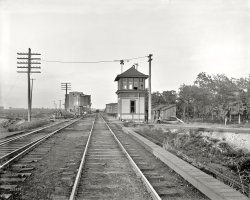
- Big Boumi: 1923
- ... seen here yesterday in the Baltimore & Ohio rail yard during the Masonic convention in Washington, D.C. The big engine wears the ... "Pioneer" carried the B&O board of directors on the railroad's first run to Ellicott Mills on May 22, 1830. In 1836, the B&O ... Posted by Dave - 05/20/2014 - 7:30am -
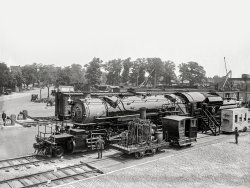
- The Red Caboose: 1943
- ... touches on a rebuilt caboose on the rip tracks at Proviso Yard, Chicago. April 1943. View full size. 4x5 Kodachrome transparency by ... track or tracks in a rail yard where locomotives and/or railroad cars are set out for minor repairs without removing the units from ... Posted by Dave - 07/30/2012 - 10:02pm -
![The Red Caboose: 1943 Chicago & North Western RR worker putting the finishing touches on a rebuilt caboose on the rip tracks at Proviso Yard, Chicago. April 1943. View full size. 4x5 Kodachrome transparency by Jack Delano.
CabooseGreat photo, Jack takes really terrific RR pictures, has he ever contributed to Trains or Railfan magazines?
[This picture is over 60 years old ... Jack died 10 years ago at the age of 83. - Dave]
KodachromeEarly Kodachrome looked so good. Color film these days has too much contrast.
Re: Kodachromeyes, i have noticed most of the pictures taken in the 40s that i have seen on this site are more crisp than the ones taken now!
American railway jargon is aAmerican railway jargon is a bit of a mystery to me. Can you tell me what "rip tracks" are?
Rip tracksRIP track
From Wikipedia, the free encyclopedia
A RIP track (RIP is an acronym for repair in place) is a designated track or tracks in a rail yard where locomotives and/or railroad cars are set out for minor repairs without removing the units from service, sometimes without even removing a freight load from the car. In some yards, a RIP track may be used for staging locomotives or "bad order" cars for major repairs. Some yards may have more than one RIP track to serve both functions.
Jack DelanoJack Delano was not a railfan per se. I am not sure he was even particularly a photographer by trade. He was a beneficiary of government funds during the FDR era. Fortunately he was sensitive to the drama of the railroads.
Interestingly, some years ago I attended a concert by a Cuban clarinet / saxophone player named Paquito d'Rivera. The music was more or less jazz/classical fusion and one of the pieces was composed by Jack Delano, who moved to Puerto Rico after the war. So Delano was a true artist in more ways than one.
Dave Nelson
(The Gallery, Kodachromes, Chicago, Jack Delano, Railroads)](https://www.shorpy.com/files/images/1a34685u_0.thumbnail.jpg)
- Xanadu: 1897
- ... octopus Many of the streets in my city were named for railroad barons, including Flagler.
Two Major Reasons for Florida's ... name of our college newspaper. The fountain in the court yard doubled as a way to aerate the water, which otherwise smelled of sulfur. ... Posted by Dave - 08/13/2012 - 7:57pm -
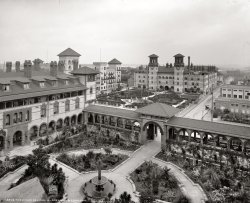
- Traffic Channel Control: 1942
- ... (IBM 402) of the machine pictured one afternoon in the railroad yard office I worked in. I was making small talk with a train conductor while ... Posted by Dave - 10/22/2014 - 9:57am -
![Traffic Channel Control: 1942 June 1942. Washington, D.C. "U.S. Office of Defense Transportation system of port control and its traffic channel control." IBM printer connected to a punch card machine. Photo by Albert Freeman, Office of War Information. View full size.
Back when you could see the bitsThis mechanical computing machinery helps us to see how far we've come in the last 70 years. Every bit of data is big enough to see on the punch cards, and every signal path is visible on the programming plugboard.
Yet, somehow, they used this stuff to get the job done.
Precious memoriesNotice the toggle switch on the tray receiving the processed cards. If too many cards come from the hopper above, the steel plate in front of the cards will nudge the toggle switch to "Off" and shut the machine down. I was running a job on a variant (IBM 402) of the machine pictured one afternoon in the railroad yard office I worked in. I was making small talk with a train conductor while running the job, and the phone rang at the other end of the office. I took the call as I watched the conductor bid me farewell with a wave, and went back to the printer. It was dead. I tried a few tricks I knew and finally gave up, calling for a service rep from IBM. The guy came in and never opened his tool kit. He walked over to the printer, looked me straight in the eye, and flipped the toggle switch to "On." Then he sat down and did his paperwork, never uttering a word all the time he was there. Never knew I could feel so small. The conductor had turned the switch to "Off" while I was on the phone. A week or two later it was my turn. Paybacks are sweet.
The frame at the end with the mini entrails is the program. Our office had about five or six of these things hanging on the wall, each one for a particular job.
Safety First!If you were not very careful your tie could get sucked into the card punch machine. Our company mandated ties for all computer operators but this rule was put to the test one day when the supervisor was fixing a misfed card and got his tie snared in the machine. He was down to the last inch or so of his tie before a co-worker shut down the machine no doubt saving his voice from being several octaves higher the rest of his life.
The next day there was a sign posted: "Ties, if worn, must be tucked into shirts."
It's a tabulator.Don't know the model number, the ones I worked on were of a later generation.
Data from 80-column punched cards were printed in neat columns on the printer. The plugboard to the left of the machine is used to program which card columns map to the printer character positions, for example: card columns 1 - 10 are printed in positions 20 - 29 on the printer. The ones I worked on could calculate running, intermediate and grand totals for specified card fields and also print running page and column headers.
In the early 1960s the functions of this sort of machine were taken over by the newer, cheaper IBM mainframes (1400 series, for example) using the RPG program. RPG was basically a report generator program which allowed the mainframe to emulate a card tabulator and sorter.
I dare say there are still some older IBM sites running ROG programs under some sort of emulation.
Doing her bitA competent, assured, and lovely young woman doing a skilled task for the war effort.
What a wonderful contrast to the KKK twit in the previous post. Dave, did you sync 'em up like that on purpose??
From Many, OneThere is cautionary narrative here for the tyrants of the world.
It is just a few months after the attack on Pearl Harbor and America's entry into World War 2. In Europe and the Orient, the Axis powers and their minions are busily impressing multitudes of subject peoples into slavery, building munitions, roads, fortifications and the like. (And those are the lucky ones -- the ones not starved, gassed and incinerated.)
Yet here in America is this lady -- a civil servant almost certainly the descendant of slaves herself, now the master of this latest arcane and inscrutable mechanism from the International Business Machines Corporation. Calmly overseeing the scheduling of, let's say, the departure of Liberty Ships from their East Coast ports to destinations in England and the Soviet Union.
And thousands more like her, gathering in their makeshift offices across the United States, day after day slowly and methodically planting the seeds of Hitler's doom.
It's an IBM 405 alphabetical accounting machineThis machine seems to have been able to process up to 150 cards per minute, or 80 alphanumeric cards per minute. It could make sums of data stored on cards, and print the results on wide paper.
Moving to the machine on the right, it's interesting to note that the frame was made with curved legs, then the machine's rectilinear covers were cut out to fit around the legs.
Ear protection?I wonder, how loud was this contraption in full swing?
In the spirit of the seasonThis reminds me of the last day before Christmas Break in college. Every year this guy would come in to the computer lab and submit a job with three drawers of punch cards. About 30 minutes later, the line printer would start playing Christmas carols. With harmony.
First came punch cards...and then came punch card wreaths and stars at Christmas. I wonder how long the cards existed before someone folded them into Christmas decorations.
[Here's an example from 1966. -tterrace]
(Technology, The Gallery, Albert Freeman, D.C., The Office, WW2)](https://www.shorpy.com/files/images/SHORPY_8d36704u.thumbnail.jpg)
- Conductor Cunningham: 1943
- ... 1943. "Freight operations on the Indiana Harbor Belt railroad between Chicago and Hammond, Indiana. Getting his waybills, Conductor ... Island Chances are good the location is the Blue Island yard office. The rolled paper looks like stored train lists that came over ... Posted by Dave - 08/30/2016 - 10:36am -
![Conductor Cunningham: 1943 January 1943. "Freight operations on the Indiana Harbor Belt railroad between Chicago and Hammond, Indiana. Getting his waybills, Conductor Cunningham telephones his yardmaster with the number of cars he has to handle and where the delivery is to be made." Medium-format negative by Jack Delano for the Office of War Information. View full size.
Poster in the upper rightBuy Bonds! Win the War!
oh REAL-ly@Kcamp I know Adolph Treidler worked out of New York, but when he made that poster he must have been using a reference photo from the Norfolk & Western, because that's one of the better portraits of a Y6 Class I've seen, in the foreground.
Paper rolled into cylindersI wonder what the function was for the paper rolled into cylinders in front?
[I'd say print-outs of previous schedules, bundled for convenient storage. -tterrace]
Also, you never see anything with scissor extensions anymore, they're the most steampunk thing ever.
American ingenuity at workCoffee can used as a lampshade. Gotta love that.
Poster in Upper LeftAdolph Treidler poster from the early 1940s.
I like my coffee lightA pot light made from a coffee can (from 1943) will look great hanging over any kitchen island. Going to add it to my list of options.
Blue IslandChances are good the location is the Blue Island yard office. The rolled paper looks like stored train lists that came over teletype machines. Notice the two tubes (left side of image) that carried waybills, train lists and such over the pneumatic tube system to various offices within the yard.
Gibson in Hammond Indianamight also be where this pic was taken. The IHB had their main offices located there, along with a big hump (Classification) yard.
The Indiana Harbor Belt at Gibson is where the billing offices processed and mailed out their accounts payable.
Tube jobLove pics having anything to do with the 40's and trains. The pneumatic tubes remind me of a summer job I had once at a large wholesaler. I worked the central tube room and distributed the tubes to stations all over the building. Fun job and the learning curve was a straight line.
(The Gallery, Jack Delano, Railroads)](https://www.shorpy.com/files/images/SHORPY-8d24289a.thumbnail.jpg)
- Always Be Careful: 1942
- ... Giant diesel-electric locomotive at Illinois Central rail yard." The safety message comes to us courtesy of Engine 9205A. Photo by Jack ... cow/calf lash-ups never became a common sight in American railroad yards.
EMD TR Evidently with a B unit attached. It's a ... Posted by Dave - 09/14/2013 - 9:48am -
![Always Be Careful: 1942 November 1942. "Chicago, Illinois. Giant diesel-electric locomotive at Illinois Central rail yard." The safety message comes to us courtesy of Engine 9205A. Photo by Jack Delano, Office of War Information. View full size.
Two engines, single cabDirectly behind the lead engine, there is what was known as a "mule". These cabless units were used when the consist dictated that more motive power was needed, but not necessarily more crew power. Novel idea, and something that couldn't be done with steam engines because of the manpower needed for each engine.
This locomotiveis actually 2 locomotives called a cow and calf, they are A & B, the A being the cab unit the B has no cab and is controlled by the A unit, I think IC had only two of these locomotives and were used in switching duties.
I am amazed from this photo to find out these type of diesel locomotives even existed let alone the cow/calf type.
Forward or backward?It is usually not difficult to tell which way a steam engine is pointed, but when diesels came along things got more complicated. Out on the road, a train has a designated direction, and when it moves in that direction it is considered to be moving "forward," but what about engines doing switching, either out on the road or in a yard? They have no overall direction, they shift back and forth constantly. Hand signals, whistle/horn signals, even verbal instructions are based on either "forward" or "reverse." But looking at an engine like this one, how do you know which is which? In this case, you could tell by which half has the operating cab (the "A" unit), but that would not work in most cases.
The solution was to label one end of every diesel locomotive with the letter "F", signifying that as the "front" or "forward" end. On this engine, it would have been on the outside corner of the frame, right next to the steps, hand railings ("grab irons"), and that old, anachronistic "pole socket." I think you can just barely make it out in the full-size view.
Cow and CalfAn EMD TR1 cow and calf unit. One of only two pairs built by GM Electro-Motive, both purchased and used by the Illinois Central.
Giant?Hardly. The units are switchers being used in duty on the hump. The cab-less unit behind is known as a slug, or less commonly as a calf, and is controlled by the other using a primitive multiple unit connection, these being the nascent days of diesel technology. Such cow/calf lash-ups never became a common sight in American railroad yards.
EMD TREvidently with a B unit attached. It's a switcher, I wouldn't call it "giant".
Locomotive and slugWhat you're seeing here is two locomotives.
Illinois Central 9205A is a 1000hp EMD NW2 built sometime after 1939. The trailing unit is almost certainly an NW2 but without a control cab and it remains attached to an "A" almost all the time.
No milk from this cowThese are Electro-Motive model NW-2 locomotives, rated at 1000 hp each. Note the trailing unit has no cab. This combination was known as a "Cow and Calf". They were kept together, with the engineer seeing equally well in both directions.
The Chesapeake and Ohio Rwy had a set of engines, nos. 9552-9554-9557 just like this, only theirs had two "calves"; thus they were called a "Cow and a Herd". [I'm not kidding...] They were sent to Baltimore where one unit was taken taken from the set and assigned to another controlling unit. They were powerful, but I didn't care for them otherwise.
No more footboards.The safety slogans are located just above the footboards, which are now illegal due to the inherent danger of crewmen riding at the end of a locomotive. Southern Pacific also used this slogan above their footboards, in addition to "Think Safety Always," "Watch Your Step," and "Look and Live."
TR1 Cow and calf mountainrev's identification of this loco is correct, it's an EMD TR1. Two sets were built in April/May 1941 for the IC, rated at 1350 hp for each unit. They had the machinery of EMD's pioneering FT cab-unit freight locos in a switcher carbody. Later renumbered 1350A&B and 1351A&B, they were scrapped in 1967.
Multiple unit control technology was hardly primitive by 1941 - it had been around since the 1890s, and applied to diesel locos since the 1920s.
(The Gallery, Chicago, Jack Delano, Railroads)](https://www.shorpy.com/files/images/SHORPY_8d23267a.thumbnail.jpg)
- The Wrong Side: 1938
- November 1938. "Houses along the railroad tracks. Omaha, Nebraska." Photo by John Vachon for the Resettlement ... the present-day Amtrak station, which abuts a former rail yard. It is also just west of railroad tracks that run north-south along the west bank of the river.
... Posted by Dave - 08/02/2017 - 9:26am -
